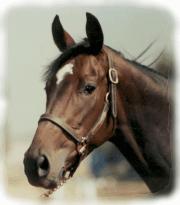A Horse, of Course with Don Blazer |
If you enjoy learning about horses, then you'll love our online courses. Each month you'll find a new column on our web site. We hope you'll enjoy it, and maybe e-mail us with questions or suggestions for other columns. A Horse, Of Course is a monthly column syndicated by Success Is Easy. If you like the column, call your local newspaper, or local horse publication and ask them to subscribe by contacting Success Is Easy. |
The Fifth Secret of Perfect Horsemanship Don Blazer copyright©2009 If we seek perfect horsemanship, then we must seek knowledge. In seeking knowledge we often discover what we know is incomplete, and being incomplete is frequently not the truth. Example: a horseman thought by many to be knowledgeable defines a snaffle bit as "a bit with a jointed mouthpiece." His knowledge is incomplete and therefore not the truth. A snaffle may have a jointed mouthpiece, but the mouthpiece does not define the bit. A bit is a snaffle only if the reins attach opposite the mouthpiece, and there is no poll or curb action. A greater understanding of bits leads us to the truth about a snaffle. Continued study improves our ability to use the bit wisely to communicate with the horse. "Pull back on the reins to stop a horse," is advice given by horse trainers and riding instructors alike. It is false advice. Such advice may sound appropriate, but it is advice based on common practice and incomplete knowledge. "Pulling" on horses is always a response based on incorrect or insufficient information. A million messages of incorrect and insufficient information are directed at us every day. Advertisements by bit makers and tack stores tell us a snaffle has a jointed mouthpiece, instructors direct us to "pull" back on the reins, and magazines contain sales pitches for products encouraging the use of horses with physical problems as if there are no consequences to the use of such products. Some one says, "I've been around horses all my life, and we've always done it this way." If you accept his or her information without question you are making a "conditioned" response. If you respond instantly in a defensive or critical manner, you are making a condition response. Conditioned responses are easy; they don't require thought or effort to seek truth. A horse steps on your toe and the conditioned response is verbal abuse to and blaming of the horse. "Stupid horse" is the conditioned response. The conditioned response is the result of a lack of self-esteem and mental laziness; it allows others to control our thinking or it lets us avoid having to think things through. Take time before responding, seek knowledge, commit yourself to constant learning, challenge all that is presented and you can apply the fifth secret of perfect horsemanship: CHOOSE YOUR RESPONSE. The horseman who seeks knowledge for the benefit of the horse will study bits, saddles, hoof balance, equine nutrition, and health care as well as training (behavior modification) and riding techniques. It is that horseman who will experience moments of perfect horsemanship for it is that horseman who will choose how he or she responds to all circumstances. In making conscious choices of response, you allow the power within (first secret) to take you to your goals. Only a conscious choice in response will follow your heart (second secret). You can practice non-judgment (third secret) by seeking your own knowledge rather than accepting another's insufficient information. Giving (fourth secret) your knowledge is the greatest expression of wisdom. When you are conscious of choosing your responses to all circumstances, you will recognize that there are only six elements which apply to any and all performance horses. Beyond the six elements there is nothing. But it is in the nothingness that the artist, the poet, the innovator begins to work his or her magic. It is in the nothingness that the training and riding transcend the physical and become thought and perfection begins. Master the six elements and your knowledge is truth and your responses are your choice. The six elements of training in sequence and understanding are: 1. All action initiates in the horse's hindquarters. 2. Communication involves a request and a response. 3. Seek compliance to requests through nonresistance. 4. Impulsion is power in movement. 5. Suppleness is the requirement for grace in action. 6. Collection is controlling the balance point. If you have not experienced moments of perfection with your horse, the incorrect response…the conditioned response is: "work harder." The conscious choice in response will be: "work smarter, learn more, gain the knowledge needed to benefit the horse." Don Blazer is the author of Nine Secrets of Perfect Horsemanship, a book he wrote for his granddaughter who won an AQHA World Championship in Youth Trail (2008). To read about the first four secrets, please visit the Archives Page. Visit A Horse, Of Course on the Internet at www.donblazer.com |
